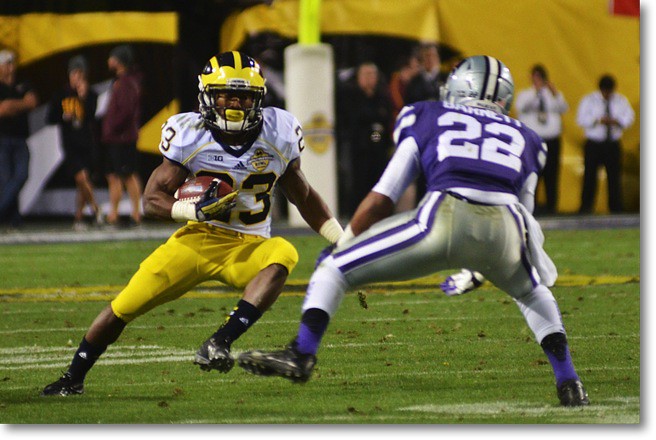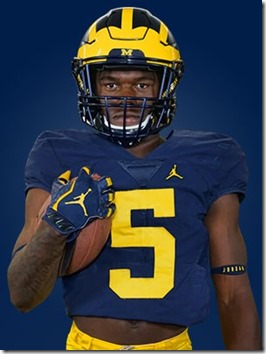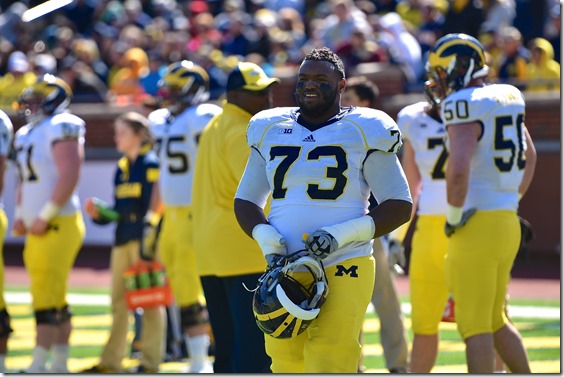dennis norfleet is the new bubble screen

Previously: Last year's profiles. S Quinten Johnson, S Daxton Hill, CB DJ Turner II, CB Jalen Perry, LB Joey Velazquez, LB Anthony Solomon, LB Charles Thomas, DE David Ojabo, DE Gabe Newburg, DE Mike Morris, DT Chris Hinton, DT Mazi Smith, OL Jack Stewart, OL Nolan Rumler, OL Zach Carpenter, OL Karsen Barnhart, OL Trente Jones, OL Trevor Keegan, TE Erick All.
| Antioch, CA – 5'9", 181 | |||||||||||||||||||
| 24/7 | 4*, #233 overall #30 WR, #31 CA |
||||||||||||||||||
| Rivals | 4*, #233 overall #37 WR, #34 CA |
||||||||||||||||||
| ESPN | 4*, 80 rating #26 ATH, #40 CA |
||||||||||||||||||
| Composite | 4*, #176 overall #16 OT, #1 IL |
||||||||||||||||||
| Other Suitors | Oregon, USC, UF, Cal, CU, Oregon State | ||||||||||||||||||
| YMRMFSPA | Chris Evans | ||||||||||||||||||
| Previously On MGoBlog | Hello post from your author. | ||||||||||||||||||
| Notes | Twitter. | ||||||||||||||||||
|
Film |
|||||||||||||||||||
|
Junior year, mostly RB:
Senior year, mostly WR:
|
|||||||||||||||||||
Players like Giles Jackson exist only to hurt me. Are they playing for someone else? If so they are lethal death machines. Are they playing for Michigan? If so they are freak-show jet sweep guys who explode into a gory mess of tires and oil the one time they are sent downfield in their careers. Then they transfer.
Michigan hasn't had a YAC merchant slot play a prominent role since Steve Breaston more than a decade ago. The short guys who've had an impact—Jeremy Gallon and Martavious Odoms—played mostly on the outside. The slots who've had an impact have been move-the-sticks route artisans (Dileo, Roundtree) without game-breaking potential. Game breakers just break.
Josh Gattis promises to break this cycle of hope, despair, and recrimination. Bizarrely, the program seemed to anticipate this and loaded up with three slot receivers despite having Pep Hamilton entrenched as the offensive coordinator. Giles Jackson is the guy Old Michigan would most clearly have wasted, because he's generously listed at 5'9" and did these ridiculous things at the Opening finals:
He showed off his athleticism at The Opening testing off the charts with a 4.43 40, 3.85 shuttle and a 38” vertical jump.
That was the #3 SPARQ score at the event and the top number from an offensive player. I tell you that the prospect of seeing that dude motion in to block on a run up the gut may well have slain me.
[After THE JUMP: is this the One Slot who was promised to us?]
I say we call him "Quick Burst, Mo Hurts." Nobody is on board with me on this. [Fuller]
- The Question:
- Seth: After the spring game which player are you bullish on, and which are you hedging?
---------------------------------------
The Responses:
Ace: Brian and I did a segment on this during the podcast, so I'll keep this relatively brief. (That's called a teaser, folks.)
MAURICE HURST had arguably the best performance of anyone during the spring game, lining up at multiple spots and blowing up plays at all of them. His first step, which was his greatest strength coming out of high school, is still very quick after adding weight, and he looks very ready to see a significant role this fall.
Given that some practice reports had him as a potential starter, it's hard not to be a little disappointed in Logan Tuley-Tillman's showing, which featured three flags and a couple olés. He was a major project coming of high school, to the point that this year was the earliest he could feasibly see the field, so it's not a devastating blow that he doesn't look ready yet. He has so much upside, though, that it would've been really encouraging to see him push into that starting five.
---------------------------------------
Adam Schnepp: I was looking for a weakness. There had to be one; the practice reports had practically reached tall-tale status, but now I see why. It almost feels like I need to pick someone else because this is too easy, but I'm bullish on JABRILL PEPPERS. I know that we've been bullish on him since last August, but now it's like Raging Bull(ishness). Except not about boxing. Or self-destruction. I was really just going for the bull imagery here.
As a hybrid space player, Peppers is going to have to read run/pass and react immediately. On the Blue offense's first play Peppers peers into the backfield, reads the handoff from Morris, and comes off the edge to take out Shallman, limiting him to a one-yard gain.
While his run stopping was adequate for an HSP, I was more impressed with Peppers' coverage skills. He played almost exclusively with a seven-yard cushion and not only was able to jam guys who had already built up a head of steam but consistently re-routed them to the side he had a help defender. I can't find a good example of this on the video thanks to BTN's zoom-o-matic cameras, but Ace can confirm that if I tweeted the above as many times as I said it to him you'd all either unfollow me or think I accidentally set up a scheduled tweet.
I'm hedging on BRIAN COLE. It's important, however, to delineate "hedging" as separate from "disappointed with." It's hard to judge a receiver when they aren't targeted often, and doubly so as the offense's predilection for two- and three-wide sets often left Cole on the sideline. I expected him to compete for time with the known commodities; I did not expect him to have the same number of receptions and receiving yards as 5-9 walk-on fullback Joe Beneducci. I wouldn't rule him out as a contributor in the fall*, but I expected the ball to be thrown his way more often last Saturday.
*(I don't think any of the receivers have locked down a spot with the exception of maybe Darboh, who was lined up against a dude who'd been a corner for maybe four practices.)
[Jump for the defensive backs are gonna be good, even if the passing game makes them look so.]

Not Just A Gimmick™, we hope. [Adam Glanzman/Special to MGoBlog]
For a player with a meager 113 yards from scrimmage in two years, Dennis Norfleet is the topic of discussion around these parts a whole lot, and that topic is usually "can we please get this guy the ball more?" This seems like an odd request to endlessly put forth regarding a player with 12 career offensive touches and zero touchdowns, but there's Norfleet atop the depth chart at slot receiver, and beyond that there's good reason to think he'll be a much bigger part of the offense this season.
Norfleet came to Michigan as the in-state recruit too talented not to offer late, even though he didn't fit the coaching staff's idea of... anything, really. He certainly didn't fit the MANBALL running back mold, nor the desire to head in the direction of fielding a receiving corps in which being 6'2" makes one a slot receiver. It felt like he was offered as an afterthought, and his usage in the years since reflected that; Norfleet would occasionally come into the game at the slot, get a totally surprising jet sweep, and head back to the bench to await his next special teams opportunity.
The problem with this wasn't so much the plays Norfleet was asked to run—getting a player that shifty in space is a good idea, and jet sweeps should accomplish that—but the obviousness of what he was going to do, and the fact that these plays often didn't fit into the larger scheme of the offense. This blog has extensively covered the constraint theory of offense—in essence, that an offense has a core set of plays, then "constraint" plays that take advantage of defenses overplaying those core plays—and that Al Borges went for more of a grab-bag approach.
Norfleet's longest career carry works as a great example of both the constraint theory and how he was misused, oddly enough. He broke a 38-yard run in last season's opener against Central Michigan when Michigan ran an end-around to him off a counter trap run; the counter action—especially the pulling right guard—drew the CMU defense to their right, and by the time the ball was pitched U-M's blockers had a very easy time sealing their men off from the real direction of the play:
This worked because Central hadn't yet learned that Michigan didn't ever really run the counter trap and that Norfleet's presence on the field almost certainly indicated he'd get the ball; it also helped that they were a 6-6 MAC team. Norfleet's runs after the opener weren't remotely as successful due to a couple factors: Michigan couldn't establish a base running game, and when Norfleet was on the field it was incredibly obvious what he'd do.
[Hit THE JUMP for the whole point of this post: how Doug Nussmeier can use Norfleet to boost Michigan's running game.]


44